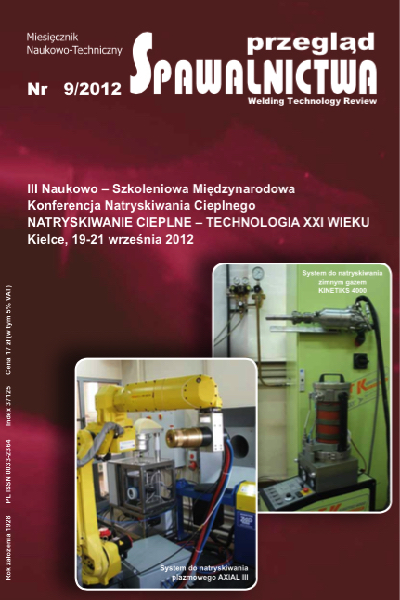Mikrostruktura i odporność na zużycie powłok natryskiwanych metodą płomieniowo-proszkową mieszaninami proszków
Main Article Content
Abstract
W pracy przedstawiono wyniki badań mikrostruktury, struktury geometrycznej powierzchni oraz składu fazowego powłok natryskiwanych metodą płomieniowo-proszkową mieszaniną proszków AmI 3001.2 i UTP Exobond 2005. Wyznaczono parametry struktury geometrycznej i obliczono wymiary fraktalne profili powierzchni. Wykonano badania zużycia ściernego i erozyjnego powłok. Powłoki o wysokiej chropowatości wykazywały dużą odporność na zużycie ścierne. Wartość zużycia zależy od składu powłoki, struktury stereometrycznej oraz właściwości powierzchni rozdziału ziaren. Powłoki zawierające 30÷60% mas. UTP Exobond 2005 wykazują niższą wartość zużycia ściernego niż powłoki wykonane z materiałów bazowych. Intensywność erozji powłok cermetalowych zawierających poniżej 50% mas. UTP Exobond 2005 jest mniejsza niż intensywność erozji powłoki natryskiwanej UTP Exobond 2005.
Microstructure and wear resistance of flame sprayed with the powder mixture coatings
Abstract
The paper presents results of investigations into microstructure, geometrical structure of the surface and phase composition of coatings flame sprayed with the mixture of AMI 3001.2 and UTP Exobond 2005 powders. Fractal dimensions and roughness parameters were evaluated. The tests of abrasive and erosive wear were done. High resistance to abrasion was revealed by high roughness coatings. Wear loss of coatings depends on coating composition, stereometric structure of the surface and intersplat surface properties. Coatings containing 30÷60% wt. UTP Exobond 2005 reveal lower wear loss in abrasion test compared to that of coatings performed from basic powders. Erosion intensity of cermet coatings containing less than 50% wt. UTP Exobond 2005 is lower than for coating sprayed with UTP Exobond 2005.
Downloads
Article Details
Creative Commons CC BY 4.0 https://creativecommons.org/licenses/by/4.0/
Welding Technology Review (WTR) articles are published open access under a CC BY licence (Creative Commons Attribution 4.0 International licence). The CC BY licence is the most open licence available and considered the industry 'gold standard' for open access; it is also preferred by many funders. This licence allows readers to copy and redistribute the material in any medium or format, and to alter, transform, or build upon the material, including for commercial use, providing the original author is credited.
References
Zum Gahr K.-H.: microstructure and wear of materials. Elsevier. nowy Jork 1987.
Hejwowski T.: Studium procesów zużywania erozyjnego, ściernego i zmęczenia cieplnego elementów maszyn oraz kształtowanie struktur o korzystnych właściwościach eksploatacyjnych. Wydawnictwo Uczelniane Politechniki Lubelskiej 2003.
Hejwowski T.: Wpływ mikrostruktury i składu chemicznego stopów na osnowie żelaza na ich odporność na zużycie ścierne oraz erozyjne. Inżynieria materiałowa 2 (2010).
Stack m.m., Chacon-nava J., Jordan m.P.: Elevated temperature erosion of range of composite layers of Ni-Cr based functionally graded material. materials Science and Technology 12 (1996).
Hoop P.J., Allen C.: The high temeperature erosion of commercial thermally sprayed metallic and cermet coatings by solid particles. Wear 223-235 (1999).
Matthews S., James B., Hyland m.: The role of microstructure in the mechanism of high velocity erosion of Cr3C2NiCr thermal spray coatings: Part I As-sprayed coatings. Surface and Coatings Technology 203 (2009).
Pennefather R.C., Hankey S.E., Hutchings R. and Ball A.: Recent observations of the erosion of hard materials. materials Science and Engineering A105/106 (1988).
Mahesh R.A., Jayaganthan R., Prakash S.: microstructural characteristics and mechanical properties of HVOF sprayed NiCrAl coating on superalloys. Journal of Alloys and Compounds 468 (2009).
Lim L.C., ming Q., Chen Z.D.: microstructure of laser-clad nikel-based hardfacing alloys. Surface and Coatings Technology 106 (1998).
Bernal J.L.P., Bello m.A.: Fractal geometry and mercury porosimetry. Comparison and application of proposed models on building stones. Applied Surface Science 185 (2001).
Li J., Lu L., Lai m.O.: Quantitative analysis of the irregularity of graphite nodules in cast iron. materials Characterization 45 (2000).
Su Y., Lei W.-S.: Relationship between fracture toughness and fractal dimension of fracture surface of steel. International Journal of Fracture 106 (2000).
Kwaśny W., Dobrzański L.A., Pawlyta m., Gulbiński W.: Fractal nature of surface topography and physical properties of the coatings obtained using magnetron sputtering. Journal of materials Processing Technology 157-158 (2004).
Wrona m.: Zastosowanie metod fraktalnych do analizy cząstek zużycia. Tribologia 2 (2003).
Amada S., Hirose T.: Planar fractal characteristics of blasted surfaces and its realtion with adhesion strength of coatings. Surface and Coatings Technology 130 (2000).
Amada S., Yamada H.: Introduction of fractal dimension to adhesive strength evaluation of plasma-sprayed coatings. Surface and Coatings Technology 78 (1996).
